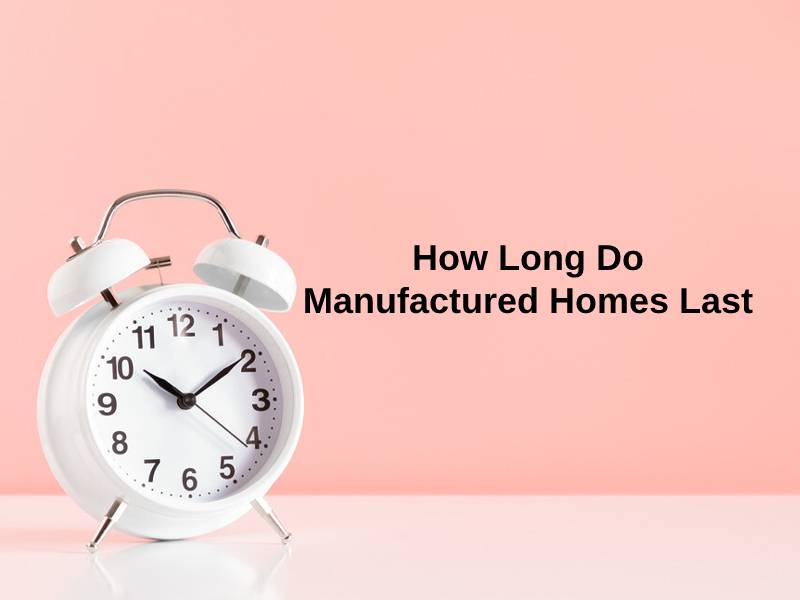Exact Answer: 30 to 55 years
Manufactured dwellings need 20 to 30% more materials than site-built homes. These homes must endure the strains of transportation from the manufacturer to the specified lot or land, thus they are built to last from beginning to end. The widespread misconception is that manufactured homes are weaker or flimsier than site-built homes, but this is not the case.
The additional materials utilized in the structure’s construction provide additional stability to the manufactured home, even in the most severe weather conditions. This construction method ensures that each factory-built home is a sturdy and long-lasting structure.

How Long Do Manufactured Homes Last?
| Types of homes | Lasts for |
| Manufactured homes | 30 to 55 years |
| Modular homes | 50 years |
Manufactured houses are designed following the HUD Code. Some examples of regulated elements include fire resistance and residential energy efficiency. A manufactured home has a life expectancy of 30 to 55 years.
Some of the characteristics that impact how long manufactured homes last are as follows:
- Maintain Your Home Properly – Maintaining your home properly is a vital component of ensuring that it lasts as long as possible. Consequently, you must take steps such as painting the exterior regularly and caulking seams that may allow water to pass through.
- Choose the Appropriate Location – Choosing the right location, particularly in locations with low humidity, can help to keep construction materials like warp and wood from decaying over time.
- Address Plumbing Leaks – Water damage can cause structural damage to your home, therefore you must be attentive about it. Take care of any plumbing problems and make sure the house is adequately ventilated.
- Quality of the material – Higher the material quality, the longer it will last. Manufactured home quality materials can have a metal roof, aluminum cladding, and windows.
The primary reason Congress enacted the HUD code in 1976 was to increase manufactured home safety and building standards, which improve residents’ living conditions. Professionals construct manufactured homes in factories. The attention to detail is what keeps a new manufactured home consistent and raises the standards.
Why Does Manufactured Homes Last For So Long?
The majority of manufactured homes are built of metal and wood. Metal-framed structures outlast wood-framed constructions. A permanent foundation is site-built and made of long-lasting materials such as concrete, mortared brickwork, and treated wood. Because the manufactured home is not site built, the foundation must be site built certified.
Today’s prefabricated homes are as solid and sturdy as any site-built home, and may even be more resistant to extreme weather such as tornadoes and hurricanes.
The weather conditions have a significant impact on the longevity of the homes. Drier climates have less of an impact on dwellings than wetter climates. This is also true for site-built buildings and automobiles. Construction is more difficult in areas where there is a lot of rain and humidity.
Several factors can reduce the lifespan of a manufactured home, including:
- Inappropriate Installation – Your mobile home’s structural integrity will undoubtedly be jeopardized if it was not correctly installed. The consequences of improper installation will become apparent over time, and you will end up paying more than you intended. To address the issue, it is strongly recommended that you have your home examined before moving in, whether it is a new or used prefabricated home.
- Founding Problems – Your prefabricated home’s foundation can shorten its lifespan. If your home is subjected to soil movement, the structure of the house may be weakened. Furthermore, this could cause home un-leveling, resulting in your door not closing properly, walls splitting, and finally plumbing leaks.
- Serious harm – Water is the most common cause of property damage. Water can cause considerable damage to a mobile home, whether through a leaking pipe or a leaking roof. Cold weather, on the other hand, can cause pipes to freeze, while hot weather can cause humidity and mildew problems.
Conclusion
When compared to site-built dwellings, manufactured housing is less expensive. They are energy-efficient and provide a great home living experience comparable to that of a stick-built home. The only significant difference between mobile homes and stick-built homes is that mobile homes are created in a factory and take far less time to build.
If you’re on a tight budget but still want to buy a prefabricated home, you can put it in a community park and pay a lot of rent. Whether you buy a new or used prefabricated house, it is critical to have it examined to ensure its useful life.




















